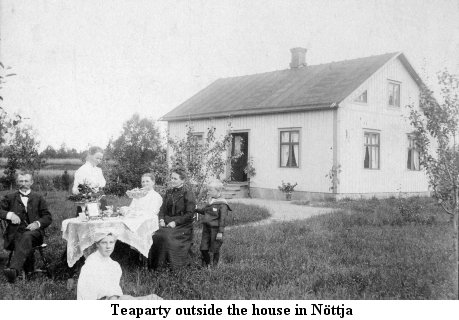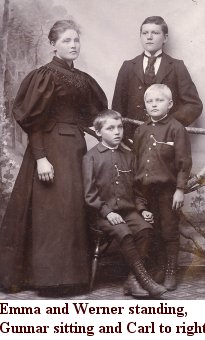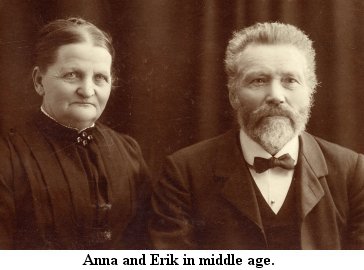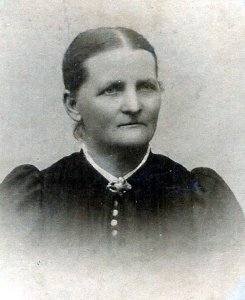Carl's mother Anna, described as a, sweet, gentle, dainty women
with a lovely singing voice lived a long and difficult life.
Anna was born Aug. 8, 1845 in the small village of Nöttja
that is in the southern Sweden province of Småland. Her father’s
occupation is unknown but the family must have been fairly well off for the
time and area. This assessment is based upon an observation made by a cousin,
Jim Huntley who was there in 1948. Jim indicated that Anna’s father was
sort of a country squire, because his house was definitely bigger and grander
than the others in the area. Huntley also speculated that Anna’s father
probably had some peasants working for him and maybe was in some kind of business.
A family tree of the Andersson family in the Nöttja area has been traced
backed to the early 1700’s. The old amateur Swedish genealogist who did
the study stopped at this date because he found out that a lady at the Kings
court had a liaison with a common soldier and fathered one of Anna’s ancestors.
The genealogist said “ I did not want to go any farther, if things like
that were happening!”
Anna was the oldest of nine children. Anna and her sister Gustava
were both schoolteachers. Gustava and Anna taught in the village of Angelstad
that was several miles from the Nöttja family home. The girls walked home
each weekend and returned to the school with food their mother packed for them
for the school week. With the exception of Gustava, who became a respected schoolteacher,
Anna and all of her siblings ended up living in the United States.
Assuming the records are correct, Anna married the tanner Eric Dahlin on her
thirtieth birthday. At that date in 1875 Eric would have been 33 and had two
children, ages four and five, from a previous marriage. Erik and his first wife,
Emma Charlotta Wilhelmina Rydell were married September 1870 and she died June
28, 1874 in Ljungby. Anna and Eric named their first child Emma who was born
in January 1877.
March 1884 had to have been a devastating time for the Dahlin family because
during that month three children died of scarlet fever. One can only image the
heartache and grief Anna had during this hopeless March, desperately nursing
these ailing children, watching three die and attending three burials all within
a month. Anna age 3 years, 11 months died March 9 and was buried March 12; Gerda
age 1 year and 26 days died March 17 and was buried March 21 and Selma, Anna’s
stepdaughter age 12 years, 3months died March 29 and was buried April 4, 1884.
In addition too the agony of having three children die, Anna had the welfare
of three young children to look after; this included, her stepson Gustaf age
13 and her own two children Emma seven and Werner six. It is not known if the
three surviving children contacted the disease but, at best, it must have been
a constant worry for Anna. Prayers of plea for family intervention must have
been common during those long Scandinavian nights since evidence exists that
Anna and  Erik
were deeply religious.
Erik
were deeply religious.
Note: Three Scarlet fever epidemics occurred in Sweden during
the late nineteenth century, one was during this period. Recent studies suggest
that food shortages and malnutrition as a leading contributor for these epidemics.
However, no firm evidence is available to link the Dahlin family to this cause.
What is known however, it that Småland because of its harsh and rocky
soil has been identified as likely the poorest place in Sweden for agriculture.
Two stories underscore this observation. One is an old Swedish myth that states
when the Lord was busy making the beautiful places in Sweden the devil sneaked
in and transformed the area into a desolate place crowed with stones and woods.
By the time the Lord caught up it was to late to change. The second is that
when someone born in Småland is put on barren land with only an axe he
would manage to have a garden within a week.
It is also worth noting that during the nineteenth century, because of the poor
conditions Småland was if not the major, a major source for Swedish immigrants
to the U.S. Independent of the potential impact of food shortages, the Dahlin
family did have an apparent advantage over much of the local population. Erik
either operated or owned a small tannery and the house they lived in Nöttja,
still in use, as apparent from a 2006 photo, is a lovely little bungalow. 
A son Gunnar was born the next year in July 1885; the arrival
of a newborn might have helped stifle the grief of the previous years deaths,
but it could have simply added more burdens to the family. Another son, Carl
was born in September of 1887 when Anna, then 42, would have been quite an old
age for childbearing.
Church records from the old Nöttja church indicated that
the family came from the parish of Ljungby in November of 1876 and moved back
to Ljungby in October 1891. All of Anna’s six children were born in Nöttja
including their last child Karl [Carl] born September 27,1887. Eric’s
two children from his first wife were born in Ljungby.
The year 1890 must have been a mixed year for the Dahlin’s because Eric
bought the Ljungby tannery; but his oldest son Gustaf, then nineteen, died in
February of that year from consumption. . Since Carl would have been two years
old when his stepbrother Gustaf died it can be understood why he only acknowledged
his three older siblings Emma, Werner and Gunnar.
A cousin Inga Lisa Eriksson grew up in Ljungby and knew the
Dahlin family well. Her grandmother Gustava was Anna’s sister; She described
Anna as a very sweet and lovely lady with a beautiful singing voice. Inga Lisa
recalled family and friends getting together on Christmas for singing that was
accompanied by accordion and a flute. (Not sure if Anna played one of these
instruments.)
 In later
years Anna and Erik lived in the old Dahlin house that now was Werner’s
home.
In later
years Anna and Erik lived in the old Dahlin house that now was Werner’s
home.
Erik, then age 82, died December 28,1923 from arteriosclerosis and Anna continued
to live alone in the Ljungby apartment. Reportedly, she was very lonely and
apparently, at a later date, agreed to move to Jamestown New York and live with
her only surviving daughter Emma [Dahlin] Gunnerson. Her loneliness after Erik’s
death can easily be understood. Although her oldest son Werner lived in Ljungby,
Gunnar was in Stockholm and both Anna and her youngest child Carl were in the
United States. Carl may not have seen his mother since 1905 when he was drafted
into the Swedish Navy followed by his 1910 immigration to the US. Carl was in
France as an American soldier during 1918 and early 1919. Why he did not visit
his parents during that period is an enigma.
Preparing for her trip to the United States Anna stayed with
her son Gunnar for a month in Stockholm. Gunnar’s daughter Ingrid, then
about nine, described her grandmother as a small, dainty and kind lady. She
also recalled her grandmother knitted her a pair of long woolen gray stockings
that she wore in the winter. The stockings were very warm but itched terribly.
The local Stockholm newspaper reported that Anna celebrated
her 80th birthday [She was born 8/8/1845] on the boat to the United States.
So she must have arrived in Jamestown NY to live with her daughter Emma during
August 1925. Anna moved with the Gunnerson’s to North Dakota about 1928
and again with them to Richmond, Indiana about 1931. Emma died age 56 on Feb
12,1933 in Richmond but was buried in Jamestown, NY. Her youngest brother, Carl
Dahlin attended the funeral.
Gunnar’s wife Edith told their daughter Ingrid that from correspondence
with Anna Kristina, Anna seemed to have trouble in the US. It is not known from
what dates these comments came.
Shortly after Emma’s death, Emma's husband David Gunnarson
shipped Anna, approaching 88, to her son Carl’s house in Syracuse New
York. This was a real hardship for the Culbert St. Dahlin's because this was
at the peak of the Great Depression and Anna arrived with no money. However,
she did bring some limited keepsakes; two that still exist. This included her
gold wedding ring and a sterling silver coffee set that may have been a wedding
gift.[See note below on Swedish coffee]
Inga Lisa Ericksson underscored Carl's brother Gunnar's repeated
anger toward Emma's husband David Gunnarson because he felt he took all of Anna's
money and left her destitute even though he was financially comfortable (the
Jamestown City Directory showed Gunnarson running a men's furnishing Business).
During Anna’s stay, Carl, like many American’s during
the Depression, lost his normal decent paying job. In his case he was as a skilled
metalworker. Instead, he had to accept his only option, a few hours a week federally
subsidized pay during the construction of a local school. This consisted of
hauling dirt and cement by wheelbarrow. His bosses were immigrant Italian bricklayers
who barely spoke English. This had to be a humiliating experience for this proud
Swede. To further underscore this pride, Gordon said Mom Dahlin would obtain
welfare bread without Carl knowing and conceal it using standard bread rappers.
This is only one example Mom Dahlin used to help with limited finances because
she knew Carl was too proud to accept welfare handouts.
Lack of money was not the only handicap with Anna’s arrival.
Anna could not speak English and nobody at their home but Carl could speak Swedish.
All of Carl and Grace Dahlin’s children recall Mom Dahlin indicating how
difficult it was because only Carl could communicate with Anna. Further, Anna
was very anxious to see Carl when he came home after work so she could talk
with someone. More importantly, Mom Dahlin often chastised Carl for not teaching
the Children Swedish. They all learned a few Swedish words on their own but
Carl was adamant. He wanted the children to be full American’s and not
tainted by a foreign language.
It is curious to note that Carl did not become a naturalized American citizen
until February 24,1933 which would have been about the time Anna arrived on
Culbert St. Why he waited until that date, particularly because he served in
the American army during WWI is unclear.
Some memories by Carl’s daughter Vivian who was six years
old when Anna arrived and son Gordon age 9-10 during Anna’s follow:
Vivian , “The house on Culbert St. had only two small
bedrooms. The boys had a make- shift bedroom in the attic and had to pass through
my bedroom to get into the attic. Anna and I shared a bed in this bedroom. Anna
was a very loving person who often hugged me and referred to me as her “Svenska
Flicka” that means Swedish girl. Mom had a Swedish translation book that
she tried to help us learn some Swedish words but of course I could not talk
to Anna. Thinking back all those years, I realize how heartbreaking it must
have been for Anna, so close to me but not to be able to talk with her granddaughter.----
I still recall and am amazed that Anna’s hair was still naturally brown
and lacked gray particularly for her advanced age.”
Gordon, “I remember letters arriving from Sweden and Anna writing, so
I assumed she maintained contact with her family in Sweden. --- Some Swedish
friends of Carl’s occasionally came in to visit her and took her to church
different times. --- She spent most of her time reading the bible and knitting.
--- On some occasions Anna and Carl sang together in Swedish but I do not remember
her playing the piano---I do not recall her doing any cooking but Mom learned
to make Swedish meatballs and I would guess that came from her. ---My grandmother
would often gently put her arms on me and try to talk to me but of course I
could not understand her. Mom would often, on such occasions, remind Dad to
teach us kids Swedish so we could understand her. However, with the exceptions
of a few words he never did. --- At one point Anna had continuous watering or
running of her eyes and I no longer saw her reading or knitting. From my observations
and that of my parents I had the opinion that Anna was near total blindness.
I understood that this was one of the reason’s my parents, with some outside
help, arranged for her to go to a Swedish old peoples home near Jamestown New
York. ---I thought she stayed with us for about two years.” Note her obituary
suggests that it was nearer a year.
Gordon also recalled that shortly after Anna
moved in, a piano arrived in a big shipping box. Gordon and his older brother
Dick used that box for a long time as a play fort. He understood that the piano
was sent to the family from the Gunnarson’s. Vivian learned to play that
piano. Also, about that time an old Anderson model car somehow showed up and
Gordon assumed this was from the Gunnarson’s. Gordon recalled that Carl
and some of his Swedish friends painted the car and the paint did not dry. Carl
did not drive but his buddies, probably under a little too much Dahlin home
brew, took Carl and the car for a spin anyway. They returned several hours later
after overturning in a cow pasture with the car completely covered with grass.
Anna spent about the last three years of her life at the Old
Peoples Home of Frewsburg NY . Frewsburg is near Jamestown, a predominantly
Swedish community. Mom Dahlin and Gordon both indicated that Anna was happy
in the Swedish home because there were other Swedes there that she could talk
to. However, Gordon did not remember any of the family members besides his father
visiting Anna during that period. Jamestown would have been a full day’s
trip at the time and Dad Dahlin did not drive.
Anna, at age 92, died November 20, 1937. Carl’s youngest
son Roger, was born December 2, 1937. Anna’s obituary mentions Carl Dahlin
as a bearer at her funeral. The obituary also identified that her sons, Verner
and Gunnar of Sweden, a brother Carl Anderson of Jamestown and a sister Augusta
Berquist of Seattle, survived her. Anna is buried in Section 3 lot No. 327 of
Frewburg’s Maple Grove cemetery.
Sweden is a coffee-drinking country
Gunnar’s grandson, Bengt Blixt provided the following commentary:
In former times you roasted your own coffee beans and ground
it, later you bought roasted coffee beans and only ground it. Then to a kettle
of water, you added a coffee-spoon of ground coffee for each cup and “one
for the kettle” and brought the kettle to boil for some minutes and the
let it stand for some minutes to let the coffee grains settle.
Then you served it taking care to avoid that the grounds
(which you don’t want to have) ended up in the cup. Usually you served
the coffee directly from the kettle, but on special occasions when you had a
party or prominent guests you served it from a ceramic or silver container.
At this time you were a very poor hostess if you did not have seven different
kinds of biscuits and cakes.
 Erik
were deeply religious.
Erik
were deeply religious. 

 In later
years Anna and Erik lived in the old Dahlin house that now was Werner’s
home.
In later
years Anna and Erik lived in the old Dahlin house that now was Werner’s
home.